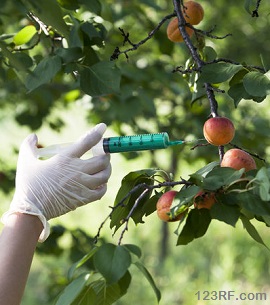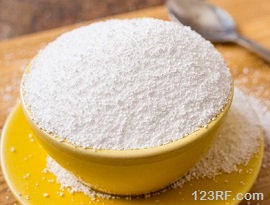You do your best to eat healthful foods. You have cereal and concentrated orange juice for breakfast, a nice big salad with a boneless, skinless chicken breast along with a diet soda for lunch and then a lean cut of steak and some green beans for supper.
You also had 4 bottles of water throughout your day. Can’t get any healthier than that, right? Wrong. The silent killers in your food hide in places you’d never even suspect.
As a matter of fact, if you ate the standard versions of everything throughout that day, EVERY SINGLE ONE OF THEM had at least one (and often several) ingredients in them that are toxic. Some of them are even potentially lethal because they cause metabolic disorders, endocrine system disruption, nervous system damage, liver damage and/or cancer. How healthy are you feeling now?
The worst part of this is that the FDA has given its stamp of approval to many of these ingredients even when solid, mainstream research shows that it’s toxic.
Why? Who knows – because the can. Because the pesticide, preservative and agricultural industries contribute big bucks to government-funded research. Because three times the amount of genetically modified foods can be grown in the same space that non-modified foods can. The excuses are endless but the poisons are still in your foods.
Here are some of the top silent killers in your foods:
Growth Hormones
Animals just can’t be grown fast enough to meet consumer demand so most of the off-the-shelf meat that you buy contains growth hormones and other chemicals that make them grow bigger and faster. There are currently six hormones that are approved by the FDA to be used in our foods. They are estradiol, progesterone, testosterone, zeranol, melengestrol acetate, trenbolone acetate. There are also several synthetic hormones approved.
All of these hormones have been linked either as contributing factors or direct causes of innumerable conditions including cancer, endocrine imbalances, mood disruptions, birth defects and thyroid disorders. Don’t worry though – the FDA says that they’re OK and we know they have our backs, right?
In the chicken and turkey industries, the birds often grow so quickly and become so large that their legs can’t hold them and they end up lying in their own waste with open sores. The good thing though, is that the chicken breast that you buy at the store is going to be HUGE. (Sarcasm intended)
Think this isn’t true? I had a friend who bought chicks that were guaranteed to be fully grown in 11 weeks. He ended up getting an extra-heavy work schedule right around the 12th week and the chickens started splitting open. They were literally growing so rapidly that they were bursting out of their skin. It was a horrific thing to witness. Consider the hormones that it took to make that happen. Tasty, right?
Cattle actually get it as an implant that slowly releases the hormones throughout the growth cycle of the cow. Alrighty then. Next.
Bisphenol A (BPA)
 This is a chemical found in reusable plastic food containers, plastic bottles and is used as a liner in food and soda cans. BPA has been linked to breast cancer and research also shows that it interferes with chemotherapy that’s used to treat breast cancer.
This is a chemical found in reusable plastic food containers, plastic bottles and is used as a liner in food and soda cans. BPA has been linked to breast cancer and research also shows that it interferes with chemotherapy that’s used to treat breast cancer.
So, not only will it give it to you, it will also inhibit your treatment. You might want to avoid this. BPA-free water bottles are pretty standard and many companies are moving away from using BPA in their plastics so be careful to purchase those products. They’ll most likely have a big “BPA-free” sticker on them because people are becoming aware of the problem.
Pesticides and Herbicides
 Hey, let me fix you a nice glass of cold pesticide and we’ll sit on the porch and talk turkey. What? That doesn’t sound at all good? Then why are you eating produce that’s covered with it? This stuff is made specifically to kill things. If that’s not sending off a big warning bell in your head, I’m not sure how to reach you.
Hey, let me fix you a nice glass of cold pesticide and we’ll sit on the porch and talk turkey. What? That doesn’t sound at all good? Then why are you eating produce that’s covered with it? This stuff is made specifically to kill things. If that’s not sending off a big warning bell in your head, I’m not sure how to reach you.
A few of the top pesticides and herbicides are:
Atrazine. 75 million pounds of it is used per year and it’s been found in groundwater and drinking water in areas that use it. It disrupts hormone systems in several ways and research suggests that it may inhibit mammary gland development. Oh, and it’s been linked to reproductive changes in wildlife.
Chlordane and Melathion. Associated with increased breast cancer risk.
Heptachor. It was used in mass quantities to protect pineapple crops in Hawaii and is now being studied to see if there’s a link between it and the huge increase in breast cancer in Hawaiian women.
Pesticides and herbicides are a bigger issue with some produce than it is with others. Search the web for the dirty dozen and the fabulous fifteen. These are lists of the foods that contain the highest and lowest amounts of pesticides. Organic produce can be wickedly expensive and sometimes it’s a waste of money. Check them out.
Benzoate Preservatives (BHT, BHA, TBHQ)
 These are used to keep fats in your food from going rancid. It’s found practically everywhere.
These are used to keep fats in your food from going rancid. It’s found practically everywhere.
Meats, cereals, nut mixes, butter, meat and instant potatoes are all places to look for them. They’ve been linked with increased cancer risk, asthma, hyperactivity and disrupting estrogen balance (and both women AND men have estrogen!)
Azodicarbonamide
Doesn’t that sound delicious? No? Well how about a big plate of spaghetti, a chocolate cupcake or a TV dinner? Sounds a little better now, doesn’t it. This is a bleaching agent that’s used in the flour that is the primary component of these foods and has been linked to asthma and cancer.
Artificial Sweeteners
 Though the government swears that these are all perfectly safe despite studies that suggest that they cause cancer, artificial sweeteners are still bad for you.
Though the government swears that these are all perfectly safe despite studies that suggest that they cause cancer, artificial sweeteners are still bad for you.
They’re man-made chemicals that, despite lacking calories, still trick your brain into believing that you’re eating sugar because of the sweet taste, then when the sugar doesn’t show up, you crave MORE sugar.
A few more toxic chemicals to avoid:
Sodium Nitrate/Nitrite
They use this preservative in processed meats and it’s linked to several different types of cancer.
Sodium/Potassium Aluminum Sulphate
You’ll find these in microwave popcorn, baked goods, process cheese products (eww) and many other packaged foods. They’re linked to neurological, reproductive, developmental and behavioral disorders.
The bottom line of it is that you don’t know what’s in your food unless you grow it yourself. Since that’s often not an option, at least for all of your food, buy organic produce. Regarding what to do for your meat, the USDA and the FDA have such inappropriate standards that it’s nearly impossible to ensure that your meat doesn’t contain hormones, antibiotics or preservatives. Educate yourself on the different labels and do the best that you can.
If you have any chemicals that you’d like to add, or solutions to offer, please share them with us in the comments section below.
This article has been written by Theresa Crouse for Survivopedia.





































































Thank you so much, Theresa, for putting this information out to people. I have been preaching this to anyone and everyone who will listen (they’re few and far between.) Most people look at me like I’ve just grown two heads and go buy their conventionally grown groceries.
I cleaned up my act after getting extremely sick from taking care of my dad for four years before he died from Alzheimer’s. I looked and felt like death warmed over. I’m blessed to live in the country and have sourced my meat, milk and eggs from carefully researched and investigated farms. My vegetables I grow myself for precisely the reasons you stated.
You will need sustained health and energy if everything goes South and this is your first line of defense. It requires dedication and discipline to do, but you can eat healthy. I have a website of information on this subject at http://HealthyEatingOnThe Run.com. I hope it’s okay to post that. There is no charge for the recipes and background info on the site so maybe it will help someone.
Thanks for the info. Eating healthy is so hard these days and labels are very confusing as I’m quite sure they are meant to be.
I reacently embarked on an anti inflamatory paleo type diet and wow I feel much better for sure as I was pretty sick with many symptoms you mention in the article. But eating clean is no easy feat and even though many people notice the difference in me, they don’t think it is possible for them to do themselves.
Yes, at first it is a bit harder, but when you get used to doing it you may never go back. Honestly once you clean up food just tastes so much better!
It’s pretty simple, eat better, feel better. If it tampered with by man it’s probably not good for you….
Good luck to all.
Great topic Theresa & Thank you for sharing this! You may also want to mention to look for NonGMO on the label. This is following the same idea. And it’s an easy way to identify a safer product.
http://www.nongmoproject.org
Excellent summary. Hopefully all the preppers take better note and don’t spend ANY money on garbage food supplies, including military MRE’s, etc.
Thanks.
I’ve just read your article, noting in particular the info about GMO’s. Strangely, today my weekly copy of Farmweek came in the mail. In it was an article about GMO’s. Pamela Ronald, an award winning plant geneticist, professor and author states”After 40 years of Commercial use in Medicines, cheeses, wine and plants, there has not been a single instance of harm to human health.” So What;s the difference between Plants and Animals? Shouldn’t harmful to one be harmful to all?
I doubt this very seriously. With the huge spike of all kinds of health issues (Diabetes, Obesity, Cancer etc.) how can he even say none of it has a single thing to do with GMO? My guess he gets funding from Monsanto and their ilk.
thank you for the through research and the twist in my stomach of the incredible bursting chicken. Forster Farms never sounded so awful.
Keep up the great work. Your pieces are very important.
Great article. You may also use some baking soda to wash off the fruits and vegetables purchased from the grocery store, yes this includes bananas and other fruits that you toss the peel, squashes, etc. The baking soda gives an abrasive tension to the surface facilitating easier removal of residual chemicals on the skins/peels of fruits and vegetables.
Enjoyed the article. However, I have a feeling you only revealed the ‘tip of the iceburg’ when it comes to harmful things we are allowed to unknowingly ingest.
Just to comment on the chicken issue … I have personally watched the life cycle of chickens raised for slaughter. What’s amazing is when the chicks are first delivered and turned loose, they all run to a corner in a small bunch. Fast forward a few weeks and there’s barely room for them to stand in the huge building. Light, Food and Water are provided 24/7. It’s an automated operation that turns out massive amounts of edible size chickens in a very short period of time.
It’s very lucrative for the owner of the chicken barn. Plus, all he has to do is clean the floor and clean/sanitize the equipment between batches … Then do a walk through daily when chickens are present (in order to remove the dead ones). Food storage bins are kept full by the supplier and delivered by truck on a regular basis.
My grandmother always raised her own chickens. No doubt one of the reasons her fried chicken was so good. Aside from the fact she also used Lard. 🙂
I knew someone who raised hogs. He would pick up a truck load of defective chocolate candy every week to feed his hogs. Hmm – sounds real healthy!